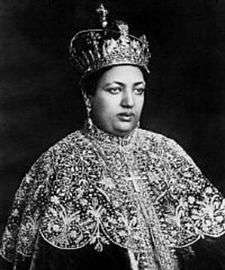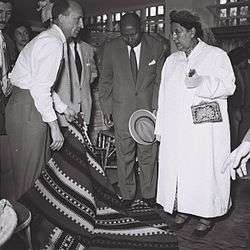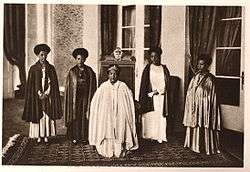Menen Asfaw
| Menen Asfaw | |||||
|---|---|---|---|---|---|
 | |||||
| Empress consort of Ethiopia | |||||
| Tenure | 2 November 1930 – 15 February 1962 | ||||
| Coronation | 2 November 1930 | ||||
| Born |
3 April 1891 Wollo province Ambassel Region at ‘Egua’ | ||||
| Died |
15 February 1962 (aged 70) Addis Ababa, Ethiopia Villa near Guenete Leul Palace | ||||
| Burial | Holy Trinity Cathedral | ||||
| Spouse |
| ||||
| Issue |
Princess Tenagnework Asfaw Wossen Princess Zenebework Princess Tsehai Prince Makonnen Prince Sahle Selassie | ||||
| |||||
| House | House of Solomon | ||||
| Father | Asfaw, Jantirar of Ambassel | ||||
| Mother | Woizero Sehin Mikael | ||||
| Religion | Ethiopian Orthodox Tewahedo | ||||
Empress Menen Asfaw (Baptismal name Walatta Giyorgis)[1] (25 Magabit 1883 Ethiopian Calendar, 3 April 1891 Gregorian Calendar[2] – 15 February 1962) was the Empress consort of the Ethiopian Empire. She was the wife of Emperor Haile Selassie.
Family
Menen was born Itege Menen Asfaw In Ambassel. She was the daughter of Asfaw, Jantirar of Ambassel. Her maternal grandfather was Negus Mikael of Wollo and her uncle was Emperor Iyasu V (Lij Iyasu).[3]
According to both published and unpublished reports, the then Woizero Menen Asfaw was first given in marriage by her family to the prominent Wollo nobleman, Dejazmach Ali of Cherecha at a very young age, as was the prevailing custom. She bore him two children, a daughter, Woizero Belaynesh Ali, and a son, Jantirar Asfaw Ali.[4] This first marriage ended in divorce, and her natal family then arranged for Woizero Menen to marry Dejazmach Amede Ali Aba-Deyas, another very prominent nobleman of Wollo. She bore her second husband two children as well, a daughter, Woizero Desta Amede, and a son, Jantirar Gebregziabiher Amede.[5] Following the sudden death of her second husband, Woizero Menen's grandfather, Negus Mikael arranged her marriage to Ras Leulseged Atnaf Seged, a prominent Shewan nobleman, who was considerably older than Woizero Menen in late 1909 or early 1910. It is unclear whether Woizero Menen was married to the aged nobleman (and secured a divorce shortly afterwards to marry her royal groom) or whether there was only an engagement between them which was broken without ado.
Woizero Menen probably met Dejazmach Tafari Makonnen (later the Emperor Haile Selassie) at the home of her uncle, Lij Iyasu. The rapport between the two may have inspired Lij Iyasu to attempt to bind Dejazmach Tafari to him more firmly through marriage ties. He therefore terminated the arrangement (whether marriage or engagement) between Woizero Menen and Ras Leulseged, and sent her to Harar to marry Dejazmach Tafari Makonnen.[5] Ras Leulseged apparently did not hold a grudge against Dejazmach Tafari for this circumstance, blaming it entirely on Lij Iyasu who had ordered it. Indeed, he was among the leaders who fought on the side of Dejazmach Tafari Makonnen in the Battle of Segale, and died in that battle.[6]
Empress

The account given in the Autobiography of the Emperor, My Life and Ethiopia's Progress, mentions no previous marriage or children of Empress Menen and no such order by Iyasu, but states only that at the age of 20, they were married by their own mutual consent, and describes her as "a woman without any malice whatsoever".[7] When Tafari Makonnen became Emperor of Ethiopia as Haile Selassie I, Menen Asfaw was crowned as Empress at his side. Empress Menen had no children by Ras Leulseged.
Empress Menen was active in promoting women's issues in Ethiopia, was Patroness of the Ethiopian Red Cross, and the Ethiopian Women's Charitable Organization. She was also patroness of the Jerusalem Society that arranged for pilgrimages to the Holy Land. She founded the Empress Menen School for Girls in Addis Ababa, the first all-girls school which had both boarding and day students. Girls from all over the Empire were brought to the school to receive a modern education, encouraged by the Empress who visited it often and presided over its graduation ceremonies. The Empress gave generously, as well as sponsored programs for the poor, ill and disabled. She was also a devoutly religious woman who did much to support the Ethiopian Orthodox Tewahedo Church. She built, renovated and endowed numerous churches in Ethiopia and in the Holy Land. Prominent among these are the St. Raguel Church in Addis Ababa's Merkato district, the Kidane Mehret (Our Lady Covenant of Mercy) Church on Mount Entoto, and the Holy Trinity Monastery on the banks of the River Jordan in the Holy Land. She gave generously from her personal funds towards the building of the new Cathedral of St. Mary of Zion at Axum, but did not live to see it completed and dedicated.
When the Empress was exiled from Ethiopia during the Italian occupation from 1936 to 1941, she made a pledge to the Virgin Mary at the Church of the Nativity in Bethlehem, promising to give her crown to the church if Ethiopia were liberated from occupation. The Empress made numerous pilgrimages to Holy Sites in then British-ruled Palestine, in Syria and in Lebanon, during her exile to pray for her occupied homeland. Following the return of Emperor Haile Selassie I and his family to Ethiopia in 1941, a replica of the crown was made for future Empresses, but the original crown that Empress Menen was crowned with at her husband's side in 1930 was sent to the Church of the Nativity in Bethlehem. Empress Menen, although often seen wearing a tiara at public events that called for it, would never again wear a full crown.
Empress Menen performed perfectly in the role of Empress-consort. In her public role she combined religious piety, concern for social causes, and support for development schemes with the majesty of her Imperial status. Outwardly she was the dutiful wife, visiting schools, churches, exhibitions and model farms, attending public and state events at her husband's side or by herself. She took no public stand on political or policy issues. Behind the scenes however, she was the Emperor's most trusted advisor, quietly offering advice on a whole range of issues. She avoided the publicly political role that her predecessor as Empress-consort, Empress Taytu Betul, had taken, which had caused deep resentment in government circles during the reign of Menelik II.
The Empress and some of her family were placed under house arrest briefly during the 1960 Imperial Guard coup attempt against her husband at her villa outside the Guenete Leul Palace grounds in northern Addis Ababa. Following the return of the Emperor and the crushing of the coup attempt, there was much speculation as to the conduct of the Crown Prince, who had been proclaimed monarch by the coup leaders. It was noted that the Crown Prince had accompanied his mother in a drive through the palace grounds, making stops at Imperial Guard posts to exchange pleasantries with the guards, on the night before the coup was launched. The ailing Empress had been urged to visit the posts by security officials, who were concerned about the soldiers' morale, and perhaps had an idea that something was brewing. The appearance of the Empress with the Crown Prince at her side may have been used by coup leaders as an indication to their followers that the Empress might sympathise with a movement that brought her favored son to the throne. It is extremely unlikely that either the Empress or the Prince had any idea of what was being plotted. However, a cloud of suspicion never left the Crown Prince, and the Empress was deeply saddened by this.
Following her death in 1962, the Empress was buried in the crypt of Holy Trinity Cathedral in Addis Ababa among the tombs of her children. Prime Minister Aklilu Hapte-Wold delivered her eulogy paying tribute to her charity, her piety, and her role as advisor and helpmate to the Emperor, as well as her personal kindness and goodness. On the third day memorial and commemoration after the funeral, the Emperor himself paid tribute to his wife by saying that although the Prime Minister had aptly described what kind of person his late wife had been, he wanted to say that during their five decades of marriage, not once had it been necessary to have a third party mediate between him and his wife, and that their marriage had been one of peace and mutual support.
Later, the Emperor built a pair of grand sarcophagi in the north transept of Holy Trinity Cathedral's nave, in order to transfer his wife's remains there and eventually be buried at her side himself. But due to the revolution, the Emperor was not buried there after his death, and the Empress remained in her original tomb in the crypt. During the ceremonial burial of her husband's remains in November 2000, the remains of Empress Menen were also disinterred from the crypt tomb, and placed in the sarcophagus next to her husband in the nave of the Cathedral, as he had originally intended.
As the consort of Emperor Haile Selassie I, Empress Menen is highly venerated by members of the Rastafari movement.
Descendants

Empress Menen and Emperor Haile Selassie were the parents of six children: Princess Tenagnework, Crown Prince Asfaw Wossen, Princess Tsehai, Princess Zenebework, Prince Makonnen, and Prince Sahle Selassie.
There is some controversy as to Haile Selassie's eldest daughter, Princess Romanework. While the living members of the royal family state that Romanework is the eldest daughter of Empress Menen,[8] it has been asserted that Princess Romanework is actually the daughter of a previous union of the emperor with Woizero Altayech.[9] The emperor's own autobiography makes no mention of a previous marriage or having fathered children with anyone other than Empress Menen.
Prince Asfaw Wossen was first married to Princess Wolete Israel Seyoum and then following their divorce to Princess Medferiashwork Abebe. Prince Makonnen was married to Princess Sara Gizaw. Prince Sahle Selassie was married to Princess Mahisente Habte Mariam. Princess Romanework married Dejazmatch Beyene Merid. Princess Tenagnework first married Ras Desta Damtew, and after she was widowed later married Ras Andargachew Messai. Princess Zenebework married Dejazmatch Haile Selassie Gugsa. Princess Tsehai married Lt. General Abiye Abebe.
Honours
National honours
-
.svg.png) Ethiopia: Knight Grand Collar of the Order of Solomon[10][11][12][13]
Ethiopia: Knight Grand Collar of the Order of Solomon[10][11][12][13] -
.svg.png) Ethiopia: Knight Grand Cordon of the Order of the Seal of Solomon[14][15][16][17]
Ethiopia: Knight Grand Cordon of the Order of the Seal of Solomon[14][15][16][17] -
.svg.png) Ethiopia: Knight Grand Cordon with Collar of the Order of the Queen of Sheba[18][19]
Ethiopia: Knight Grand Cordon with Collar of the Order of the Queen of Sheba[18][19] - Imperial Coronation Medal (1930).
- Refugee Medal (1944).
- Jubilee Medal (1955).
Foreign honours
- Member of the Royal Order of the Seraphim (Kingdom of Sweden, 19 December 1959).[1]
Ancestry
| Ancestors of Menen Asfaw | ||||||||||||||||||||||||||||||||||||||||||||||||||||||||||||||||||||||||||||||||||||||||||||||||||||||||||||||||||||||||||||||||||||||||||||||||||||||||||||||||||||||||||||||||||||||||||||||||||||||||||||||||||||||||||||||||
|---|---|---|---|---|---|---|---|---|---|---|---|---|---|---|---|---|---|---|---|---|---|---|---|---|---|---|---|---|---|---|---|---|---|---|---|---|---|---|---|---|---|---|---|---|---|---|---|---|---|---|---|---|---|---|---|---|---|---|---|---|---|---|---|---|---|---|---|---|---|---|---|---|---|---|---|---|---|---|---|---|---|---|---|---|---|---|---|---|---|---|---|---|---|---|---|---|---|---|---|---|---|---|---|---|---|---|---|---|---|---|---|---|---|---|---|---|---|---|---|---|---|---|---|---|---|---|---|---|---|---|---|---|---|---|---|---|---|---|---|---|---|---|---|---|---|---|---|---|---|---|---|---|---|---|---|---|---|---|---|---|---|---|---|---|---|---|---|---|---|---|---|---|---|---|---|---|---|---|---|---|---|---|---|---|---|---|---|---|---|---|---|---|---|---|---|---|---|---|---|---|---|---|---|---|---|---|---|---|---|---|---|---|---|---|---|---|---|---|---|---|---|---|---|---|
| ||||||||||||||||||||||||||||||||||||||||||||||||||||||||||||||||||||||||||||||||||||||||||||||||||||||||||||||||||||||||||||||||||||||||||||||||||||||||||||||||||||||||||||||||||||||||||||||||||||||||||||||||||||||||||||||||
Notes
| Wikimedia Commons has media related to Royalty of Ethiopia. |
- 1 2 Royal Ark
- ↑ "ed. Anjahli Parnell | Empress Menen Asfaw, The Mother of the Ethiopian Nation". Roots-publishing. 2011. p. 3.
- ↑ Ethiopian Review, Volume 2, Issue 10. 1992. p. 29. Retrieved 8 May 2015.
- ↑ Ambassador Zewde Retta, Tafari Makonnen, Rejimu ye Siltan Guzo ("Tafari Makonnen, the Long Journey to Power")
- 1 2 Zewde Retta, Tafari Makonnen
- ↑ Woizero Menen and the future Emperor were married in July 1911. At the time of this final marriage, Woizero Menen, the mother of four children, already once widowed and at least once divorced, was only twenty years old. The circumstances of the marriage, how it came about, and details of Woizero Menen's past marriages, are all detailed in two sources: the unpublished memoirs, preserved in the U.S. Library of Congress), of Ras Imru Haile Selassie, the cousin and childhood companion of Emperor Haile Selassie, who was party to the marriage arrangements and was intimately acquainted with these events; as well as in the Amharic biography Tafari Makonnen, Rejimu ye Siltan Guzo ("Taffari Makonnen, the Long Journey to Power") by Zewde Retta.
- ↑ Haile Selassie, My Life and Ethiopia's Progress (Chicago: Frontline Distribution International, 1999), pp. 41f.
- ↑ "Granddaughter Esther Selassie's website genealogy". Afronord.tripod.com. Retrieved 12 September 2010.
- ↑ Mockler, p. xxvii.
- ↑ http://www.voutsadakis.com/GALLERY/ALMANAC/Year2010/Jul2010/07232010/800px-Hailejubilee.jpg
- ↑ http://acelebrationofwomen.org/wp-content/uploads/2010/11/Selassie-Menen.jpg
- ↑ http://www.roots-publishing.com/roots-publishing.com/Trivia_Big_Up_files/shapeimage_2.png
- ↑ http://3.bp.blogspot.com/-uYoxf15ehJw/UQGZz8uxq2I/AAAAAAAAB4c/hqcJnxgX1w8/s1600/omega+jubilee.jpg
- ↑ https://s-media-cache-ak0.pinimg.com/736x/17/00/df/1700df759cfb7254aa41c8833eec80e6.jpg
- ↑ https://s-media-cache-ak0.pinimg.com/236x/8b/00/ec/8b00ecbda814a49cca8de75bc3d65775.jpg
- ↑ https://s-media-cache-ak0.pinimg.com/736x/63/e4/24/63e42486dac1a9253253dc486140df9a.jpg
- ↑ http://31.media.tumblr.com/16e77fd585292c22ea8ea46648cb9d90/tumblr_inline_mwf0iyIevU1qizi9m.jpg
- ↑ http://www.roots-publishing.com/roots-publishing.com/About_the_Book_files/shapeimage_1.png
- ↑ http://www.raszebi.webspace.virginmedia.com/images/empress.gif
| Menen Asfaw Born: 25 March 1889 Died: 15 February 1962 | ||
| Royal titles | ||
|---|---|---|
| Vacant Title last held by Seble Wongel Hailu |
Empress consort of Ethiopia 2 November 1930 – 15 February 1962 |
Monarchy abolished |